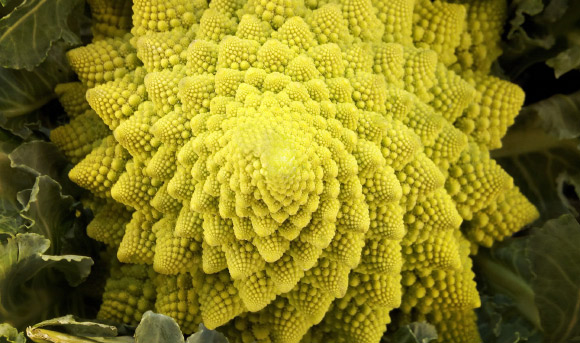Cauliflowers present an unusual organ arrangement with a multitude of spirals nested over a wide range of scales. How such a fractal, self-similar organization emerges from developmental mechanisms has remained elusive until now. According to new research, cauliflowers are in fact buds that are designed to become flowers but which never reach their goal; the atypical shape of the Romanesco cultivar is explained by the fact that its stems produce buds more and more rapidly.
“There are many examples of fractals in Nature, such as ice crystals or branches on trees. In maths, the number of copies of an initial pattern goes on infinitely,” said co-author Dr. Etienne Farcot, a researcher in the School of Mathematical Sciences at the University of Nottingham.
“Cauliflowers present a high level of such self-similarity, involving seven or more copies of the same bud.”
“This is most conspicuous on the Romanesco cauliflower, one of the first images that will appear if you search ‘plant fractals’ online. What is striking about the Romanesco is the very well defined, pyramidal buds which accumulate along endless spirals.”
“After over a decade of collaborative work from a multidisciplinary and international team of researchers, this emergent process can finally be explained,” he added.
“Although most plants present a geometric organization in spirals along main and secondary axes (called phyllotaxis), cauliflowers present an unusual phyllotaxis with a multitude of spirals, nested over a wide range of scales.”
“How such a fractal self-similar organization emerges from developmental mechanisms has, until now, remained elusive.”
In their research, Dr. Farcot and colleagues combined mathematical modeling and plant biology to show that instead of reaching flowering stage cauliflowers develop into stems, which in turn continue trying to produce flowers.
The cauliflower is born from this chain reaction, resulting in a succession of stems upon stems.
The findings show that the brief incursion of buds into a flowering state profoundly affects their functioning and allows them, unlike normal stems, to grow without leaves and to multiply almost infinitely.
The atypical shape of the Romanesco cauliflower is explained by the fact that its stems produce buds more and more rapidly, whereas the production rate is constant in other cauliflowers.
This acceleration gives each floret a pyramidal appearance, making the fractal aspect of the structure clear.
The study highlights how the selection of mutations in plants during the process of domestication has changed their shape, sometimes drastically, into the fruits and vegetables on our shelves.
“Combining experimental analyses in a cauliflower-like mutant of Arabidopsis thaliana with modeling, we found that curd self-similarity arises because the meristems fail to form flowers but keep the ‘memory’ of their transient passage in a floral state,” the scientists said.
“Understanding this genetic mutation could help plant scientists optimize growth of related plants.”
“It is amazing how complex nature is,” Dr. Farcot said.
“The next time you have cauliflower for dinner, take a moment to admire it before you eat it.”
The findings were published in the July 9, 2021 issue of the journal Science.
_____
Eugenio Azpeitia et al. 2021. Cauliflower fractal forms arise from perturbations of floral gene networks. Science 373 (6551): 192-197; doi: 10.1126/science.abg5999








